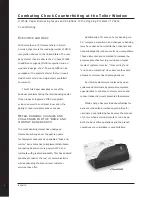
C
OUNTERFEIT CHECKS MAKE
THEIR MARK
Duplicating a check to create a counterfeit is
actually a two-part process. The counterfeit must
not only look identical to the original, but also
behave like the original. To behave as the original,
it must have magnetic ink properly printed on the
MICR line.
Early counterfeit attempts did not have or
need magnetic ink and the reason was simple.
With visual inspection and instinct as the only
guide, tellers were unable to determine which
checks had magnetic ink and which did not.
Banks looking for a simple easy-to-use solution
turned to check readers that had become popular
with retailers. Because a check reader could
quickly determine whether magnetic ink was
present, banks began to deploy check readers at
the teller window. The initial impact was dramatic.
Professional crime rings and local amateurs were
forced to regroup.
In addition to stopping or
deterring check fraud, the MICR reader helped
to speed transactions by reading the MICR and
pre-filling teller screens.
3.
FIRST UNION USES
INGENICO MICR READERS
TO REDUCE KEYING ERRORS
AND COUNTERFEITS
First Union began deploying Ingenico
MICR readers as part
of the bank’s initiative to improve
efficiencies in the branch.
"Ingenico provides our branches with check
readers that save both time and money by
minimizing the amount of keystroke errors and
reducing the amount of time the
consumer spends in the teller line"
Wayne Gardner
Vice President,
Systems Development Division
INGENICO



















